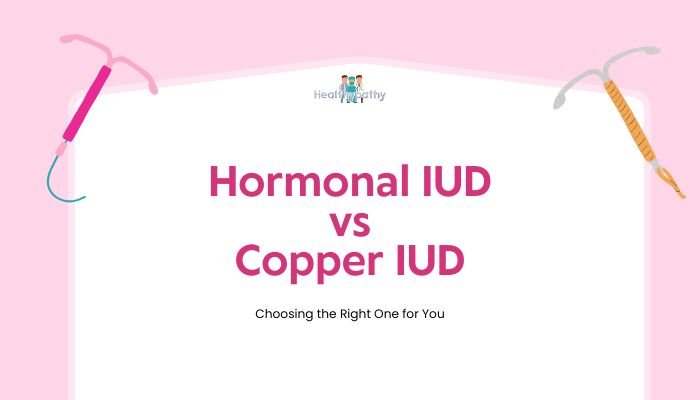Introduction
Intrauterine devices (IUDs) rank among the most effective and convenient forms of birth control. They offer extended protection with minimal user effort, placing them high on the list of “set-it-and-forget-it” contraceptives. Within this category, two main types stand out: the hormonal IUD (like Mirena, Kyleena, Skyla, Liletta) and the copper IUD (ParaGard).
While both share the T-shaped design and placement in the uterus, they differ significantly in how they prevent pregnancy, how they affect periods, and the kinds of side effects they may produce.
This article looks closely at the hormonal IUD versus the copper IUD, explaining their advantages and drawbacks to help you decide which one suits your health needs and lifestyle preferences.
What Is an IUD?
An IUD is a small, flexible, T-shaped device a healthcare professional inserts into the uterus through the cervix. Both hormonal and copper IUDs operate locally in the uterus rather than altering your entire system extensively (though some systemic effects can still occur with hormonal versions). Key features:
- High Efficacy: Over 99% effective with typical use.
- Long-Acting: Depending on the type, they can remain in place for 3–12 years.
- Reversible: Fertility typically returns quickly upon removal.
Hormonal IUD Basics
How It Works
Hormonal IUDs release a small, steady dose of progestin (levonorgestrel). This hormone:
- Thickens Cervical Mucus: Makes it tougher for sperm to enter the uterus.
- Thins the Uterine Lining (Endometrium): Reduces the likelihood of implantation if fertilization occurs.
- Suppresses Ovulation (Sometimes): Some women may stop ovulating, but it’s not guaranteed.
Pros of Hormonal IUDs
- Lighter Periods: Many users see reduced menstrual flow, and some have minimal or no bleeding after a few months.
- May Relieve Cramps: The localized progestin often alleviates menstrual pain.
- Long-Term Protection: Approved for 3–7 years, depending on brand.
- Potential Treatment for Heavy Bleeding: Can be therapeutic for conditions like fibroids or endometriosis (with your doctor’s guidance).
Potential Drawbacks
- Hormonal Side Effects: While the hormone primarily acts locally, some users report mood changes, headaches, or breast tenderness.
- Spotting or Irregular Bleeding: Common in the first few months.
- Cost Up Front: Unless covered by insurance, initial insertion can be more expensive (though cheaper long-term).
Copper IUD Essentials
How It Works
The copper IUD (ParaGard) contains no hormones. Instead, a thin copper coil wrapped around the device creates a local inflammatory reaction toxic to sperm and eggs:
- Sperm Mobility Inhibition: Copper ions disrupt sperm movement, reducing fertilization chances.
- Non-Hormonal: Does not affect ovulation or your body’s hormone balance.
Pros of Copper IUDs
- Hormone-Free: Ideal for those sensitive to or preferring to avoid hormones.
- Long Lifespan: Effective for up to 10–12 years.
- Emergency Contraception: If inserted within 5 days of unprotected intercourse, can prevent pregnancy as a highly effective post-coital measure.
- Immediate Fertility After Removal: No hormonal washout period.
Potential Drawbacks
- Heavier Periods and More Cramps: Many experience increased menstrual bleeding and stronger cramps, especially initially.
- No Hormonal Benefits: Unlike the levonorgestrel IUD, it won’t lighten periods or ease hormonal issues.
- Possible Spotting: Irregular spotting can occur in the first few months.
Key Differences to Consider
Menstrual Effects
- Hormonal IUD: Typically lighter or nonexistent periods over time.
- Copper IUD: Often heavier flows and more cramping, at least initially.
Hormone Content
- Hormonal IUD: Contains progestin, minimal but can still cause hormonal side effects for some women.
- Copper IUD: Hormone-free; you maintain a natural cycle.
Duration of Use
- Hormonal IUD: Usually 3–7 years, depending on the brand.
- Copper IUD: Up to 10–12 years of coverage.
Cost and Coverage
- Varies by Region: Some insurance plans cover IUDs fully. Others require copays or fees. Check potential costs before deciding.
- Long-Term Savings: Despite a higher initial cost, each device can average out to be affordable per year compared to monthly pills.
Potential Side Effects and Risks
Common Experiences
- Insertion Pain: Both types may cause brief, intense cramping. Some providers recommend pain relief before or during the procedure.
- Expulsion: Rarely, the IUD may slip out of place, more common in the first few months or postpartum.
- Uterine Perforation: Extremely rare but can happen during insertion (less than 1 in 1,000).
Infection Risk
Insertion itself has a small risk of introducing bacteria, leading to pelvic inflammatory disease (PID). If a user has an undiagnosed STI at the time of insertion, infection risk increases. Testing for STIs or discussing sexual history with your healthcare provider can reduce these risks.
Checking IUD Strings
Each IUD has thin strings that hang through the cervix into the vagina. Regularly feeling for these ensures the device is still in place. If strings vanish or length changes dramatically, consult a doctor to check for displacement.
Who Might Prefer a Hormonal IUD?
- Women Seeking Lighter Menstrual Flow: Ideal for those with heavy periods or anemia.
- Those with Dysmenorrhea (Painful Periods): Progestin can ease cramps over time.
- Endometriosis Management: Hormonal IUDs can help reduce pain (with medical supervision).
- Okay with Potential Hormonal Side Effects: Mood changes, breast tenderness, or slight risk of cyst formation.
Who Might Prefer a Copper IUD?
- Hormone Avoidance: Women who can’t or prefer not to use hormonal methods.
- Long-Term Simplicity: One insertion for up to a decade.
- Peace of Mind for Natural Cycles: Menstrual cycle remains unaffected (though heavier, crampier periods may occur).
- Emergency Contraception Use: If placed within 5 days post-intercourse, it’s the most effective method to prevent pregnancy.
Making the Decision: Questions to Ask
- How Do I Feel About My Period?
- If the idea of heavier bleeding and stronger cramps is concerning, a copper IUD may not be ideal.
- A hormonal IUD might lighten or even stop periods.
- Am I Okay with Hormones?
- If you have hormone-related migraines or a strong preference to avoid synthetic hormones, consider copper.
- Otherwise, a hormonal IUD’s local progestin may have fewer systemic effects than typical birth control pills.
- How Long Do I Want Contraception?
- Copper IUD can last a decade plus. Hormonal versions have shorter labeled durations but still multiple years.
- What Are My Health Conditions?
- Certain conditions (like certain clotting disorders, especially with estrogen-based methods) might be less relevant for a levonorgestrel IUD, but always consult a professional.
- Heavy periods or known anemia might worsen with copper.
- Cost and Coverage?
- Check insurance coverage. Some fully cover certain IUDs, altering cost differences.
Consulting Your Healthcare Provider
A thorough evaluation includes:
- Medical History: Blood disorders, pelvic conditions, or possible allergies.
- Lifestyle: Desire for children soon or need for a fuss-free approach.
- Exam or Tests: Pelvic exam, STI screening if needed. Possibly an ultrasound to ensure appropriate uterine size/shape.
Your provider can share success rates, common experiences, and adjust the insertion timing (like during your period, when the cervix is slightly open) to minimize discomfort.
Conclusion
Choosing between a hormonal IUD and a copper IUD boils down to your personal preferences regarding hormones, period management, potential side effects, and length of use. Both options offer robust, near “set-and-forget” contraception with minimal daily upkeep. Discussing your health history, period experiences, and future family plans with a knowledgeable healthcare provider is the best way to determine which type aligns with your needs.
Whether you seek lighter monthly bleeding or want to remain 100% hormone-free, an IUD can provide effective, long-term reproductive control—empowering you to focus on your life with assurance that your birth control is reliably in place.
References
- American College of Obstetricians and Gynecologists. Long-Acting Reversible Contraception (LARC): IUDs and Implants. ACOG Practice Bulletin. 2020.
- Trussell J. Contraceptive failure in the United States. Contraception. 2021;101(3):113–120.
- National Health Service (NHS). Your guide to IUDs. (Accessed May 2025).
- Office on Women’s Health (OWH). Intrauterine devices (IUDs). (Accessed May 2025).
- Mansour D, Inki P, Gemzell-Danielsson K. Efficacy of contraceptive methods: a review of the literature. Eur J Contracept Reprod Health Care. 2010;15(1):4–16.
- Dean G, Goldberg AB. Copper T 380A Intrauterine Device for Emergency Contraception. Cochrane Database Syst Rev. 2018;12:CD007894.
- Hubacher D, Chen P-L, Park S. Side effects from the copper IUD: do they decrease over time? Contraception. 2009;79(5):356–362.
- Bahamondes L, Monteiro I. Levonorgestrel-releasing intrauterine system: uses and controversies. Expert Rev Med Devices. 2021;18(11):1027–1035.







